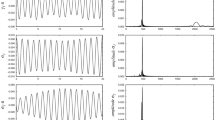Abstract
A study is performed to find the minimum-order model that can achieve an accuracy of 1 km in the dynamic propagation of the Saturnian satellites over a period of four years. The need for such an investigation has risen out of recent advances in the accuracy of orbit determination techniques that are to be used in the Cassini mission. Effects such as Saturn’s rings, tides on Saturn and the satellites, gravity harmonics on Saturn and the satellites, other solar system bodies, small Saturnian satellites, coupling of the satellite attitudes with translational dynamics, and general relativity are considered. A conservative assessment of the effects that must be modeled is obtained with numerical simulation using a fixed set of initial conditions for the satellites. This simple method is shown to exaggerate the impact of new modeling effects, so a second method is employed where the initial conditions are adjusted in order to minimize the perturbations of new effects. The second method suggests that, in addition to the point mass interactions of the eight major Saturnian satellites, the minimum order model includes zonal harmonics of Saturn up through eighth order, Saturn’s rings, Janus, the asphericities of Mimas and Enceladus, and the point mass effects of the Sun and Jupiter.
Similar content being viewed by others
References
JONES, J. B., HILDEBRAND, C. E., and JACOBSON, R. A. Private communication, 1996, Jet Propulsion Laboratory, Pasadena, CA.
CHOBOTOV, V. A. Orbital Mechanics, American Institute of Aeronautics and Astronautics, Inc., Washington, D.C., 1991.
GAVRILOV, S.V. and ZHARKOV, V. N. “Love Numbers of the Giant Planets,” Icarus, Vol. 32, 1977, pp. 443–449.
LOVE, A.E.H. Some Problems of Geodynamics, Dover Publications, Inc., New York 1967, pp. 49–57.
BURNS, J. A. (editor) Planetary Satellites, The University of Arizona Press, Tucson, AZ, 1977, pp. 113–156.
PEALE, S. J., CASSEN, P., and REYNOLDS, R.T. “Tidal Dissipation, Orbital Evolution, and the Nature of Saturn’s Inner Satellites,” Icarus, Vol. 43, 1980, pp. 65–72.
KROGH, F.T., NG, E.W., and SNYDER, W.V. “The Gravitational Field of a Disk,” Celestial Mechanics, Vol. 26, 1982, pp. 395–405.
SCHEERES, D. J. and VINH, N. X. “Satellite Dynamics about a Planet with a Narrow Ring,” Advances in the Astronautical Sciences: Spaceflight Mechanics, Vol. 82, Part II, 1993, pp. 747–764.
LASS, H. and BLITZER, L. “The Gravitational Potential Due to Uniform Disks and Rings,” Celestial Mechanics, Vol. 30, 1983, pp. 225–228.
McCUSKY, S.W. Introduction of Celestial Mechanics, Addison-Wesley Publishing Co., Reading, Massachusetts, 1963.
GOLDREICH, P. and PEALE, S.J. “Spin-Orbit Coupling in the Solar System,” The Astronomical Journal, Vol. 71, No. 6, pp. 425–438.
VINH, N. X. “Sur Les Solutions Périodiques du Mouvement Plan de Libration des Satellites et des Planètes,” Celestial Mechanics, Vol. 8, pp. 371–403, 1973.
MEASE, K. D., WOOD, L. J., BERGAM, M. J., and WHITE, L. K. “Estimation of Solar Gravitational Harmonics with Starprobe Radiometric Tracking Data,” Journal of the Astronautical Sciences, Vol. 31, No. 1, pp. 3–22.
WILL, C. F. “The Theoretical Tools of Experimental Gravitation,” Experimental Gravitation, Bertotti, B., ed., Academic Press, New York, 1974, pp. 1–105.
ZHARKOV, V.N., LEONTJEV, V.V., and KOZENKO, A.V. “Models, Figures, and Gravitational Moments of the Galilean Satellites of Jupiter and Icy Satellites of Saturn,” Icarus, Vol. 61, 1985, pp. 92–100.
CAMPBELL, J. K. and ANDERSON, J. D. “Gravity Field of the Saturnian System from Pioneer and Voyager Tracking Data,” The Astronomical Journal, Vol. 97, No. 3, May 1989, pp. 1485–1495.
DANBY, J. M. Fundamentals of Celestial Mechanics, The Macmillan Company, New York, 1962.
Author information
Authors and Affiliations
Rights and permissions
About this article
Cite this article
Tragesser, S.G., Longuski, J.M. Modeling Issues Concerning Motion of the Saturnian Satellites. J of Astronaut Sci 47, 275–294 (1999). https://doi.org/10.1007/BF03546204
Published:
Issue Date:
DOI: https://doi.org/10.1007/BF03546204




